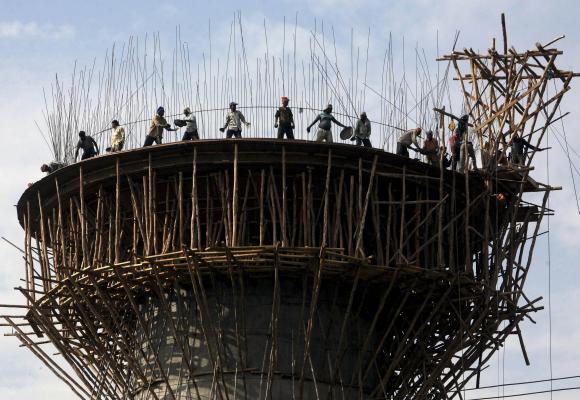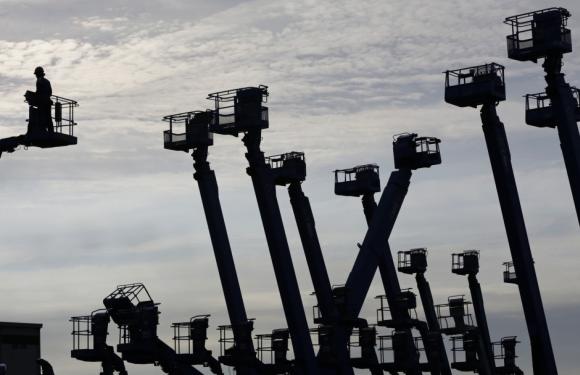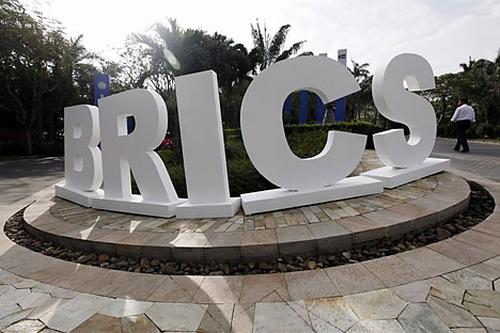Photographs: Parth Sanyal/Reuters Bruno Carrasco
The government needs to create a sustainable bond market and cut the fiscal deficit.
The recent slowdown of the Indian economy has brought to light a critical challenge facing policy makers, namely how to shift infrastructure spending into higher gear.
Without a significant increase in investment, the country will not be able to raise growth rates to its full potential, build up infrastructure and, in turn, attract greater private investment in the economy. It would also slow progress in raising households out of poverty.
Underscoring this challenge, the Planning Commission has identified $1 trillion in infrastructure investment finance requirements over the next five years.
The good news is that the government was largely successful in meeting its earlier five-year target.
The helpful news is that over the next five years, the government is not alone and can depend on the private sector, including through public-private-partnership initiatives, to help finance nearly half of the $1 trillion investment needed.
...
How India can raise $1 trillion for infra projects
Image: Labourers work on the construction of a water tank in Jammu.Photographs: Amit Gupta/Reuters
The ability to meet this target will critically depend on two factors. First, the authorities' ability to successfully increase reliance on the bond market as an alternative source of financing to bank loans.
Second, their ability to implement fiscal consolidation as a means of freeing up bank lending and reducing upward pressure on interest rates. The two are closely linked.
India will need to borrow increasingly in the domestic market if it is to meet this target, since it has limited fiscal space and faces ceilings in terms of instruments such as external commercial borrowings.
More generally, it faces a widening current account deficit - the latest figure reaching 6.7 per cent of the gross domestic product, or GDP (October-December 2012) - that constrains its scope to expand domestic investment and its balance of payments position.
So far, banks have been the main providers of infrastructure financing. While this is not an optimal arrangement, given the long-term financing required for infrastructure investment, banks have been successful in financing greenfield projects.
...
How India can raise $1 trillion for infra projects
Photographs: Reuters
However, they are now facing a number of barriers to expand lending to infrastructure, including regulatory constraints such as exposure limits to groups (infrastructure companies) as well as sectors to prevent the build-up of asset liability mismatches in the system.
Financial stability considerations warrant a focussed enforcement of these measures as the Reserve Bank of India (RBI) is undertaking.
This raises the fundamental question of where India is to source funding of further infrastructure expansion. The logical choice is the domestic bond market.
India is in a relatively strong position to develop the market as it sits on over 30 per cent of gross domestic savings as a share of GDP.
This large savings rate reflects favourable demographics, rising income per capita, and the supply of an increasing set of savings instruments for corporations and households.
India also has a flourishing government bond market that provides an important stepping stone towards the development of the corporate bond market.
...
How India can raise $1 trillion for infra projects
Image: Asian Development Bank headquarters in Manila.Photographs: Cheryl Ravelo/Reuters
Developing the corporate bond market, including for infrastructure bonds, will allow more effective mobilisation of long-term financing. Indeed, insurance companies and pension funds in India - eager for long-term assets to match their long-term liabilities - are estimated to hold $330 billion in funds that are currently largely invested in government securities.
While there are challenges that need to be addressed to make more productive use of these funds, such as investment guidelines that restrict investment by insurance funds to investment grade-rated instruments, there are practical solutions that can address these challenges, including use of credit enhancements.
Indeed, international financial institutions such as Asian Development Bank (ADB) have recognised that bond market development is the other side of the coin of infrastructure financing.
Accordingly, ADB is supporting innovative pilot demonstration projects by providing partial credit guarantees as a means to enable take-out financing through the bond market.
...
How India can raise $1 trillion for infra projects
Photographs: Jason Lee/Reuters
This serves the double objective of freeing bank balance sheets to support greenfield projects while bond holders, who have a relatively lower tolerance for risk, provide financing of post-construction or brownfield projects, improving allocation of funding across the market.
Success indicators over the medium term on this front include the creation of project infrastructure bonds as an asset class in the Indian market and establishing a commercially-oriented guarantee fund to credit enhance bonds. ADB is also actively supporting the latter.
A critical question that has not made it into the mainstream policy debate is: what is the cost of financing the trillion-dollar infrastructure bill?
Currently, India has among the highest interest rates among the BRICS (Brazil, Russia, India, China and South Africa) nations.
The current yield on the 10-year government bond in India is slightly over 8 per cent compared with below 4 per cent in the People's Republic of China.
Lower interest rates could generate substantial financial savings for India even as it borrows heavily for infrastructure.
...
How India can raise $1 trillion for infra projects
Photographs: Reuters
A back-of-the-envelope calculation suggests that a 300 basis points drop in interest rates on $1 trillion of borrowing over 10 years would lead to a savings of approximately $195 billion over the first five years alone.
Delving deeper, what holds back the lowering of interest rates? With inflation above target, the RBI will use its policy rate to stabilise inflation.
While recognising the finer arguments of the impact of cost-push and demand-pull factors on inflation, the appropriateness of the monetary policy stance and its transmission to longer-term interest rates, the supply-side constraints reflecting the poor state of infrastructure in the country is indeed a leading factor explaining cost-push inflation.
Lax fiscal policy also places further pressure on interest rates and the central bank is forced to keep policy rates higher than what would otherwise be the case with a lower fiscal deficit.
With reduced fiscal deficits, the large amount of bank lending tied up in buying government securities could fall and lending could be directed to other areas in the economy such as capital formation through working capital loans, thereby further contributing to investment in the economy.
...
How India can raise $1 trillion for infra projects
Photographs: Reuters
ADB continues to support fiscal consolidation at the state level in India as a means to improve productive spending - from recurrent to capital expenditure.
While large upfront fiscal consolidation may not be realistic, steady and incremental consolidation targeting expenditure containment will have to be steadfastly pursued.
The 14th Finance Commission is expected to continue setting the bar high in terms of improving state finances.
Equally important, the central government needs to push through with the timely introduction of Goods and Services Tax legislation, which could reduce the fiscal deficit and relieve pressure on banks to finance the deficit through large directed purchases of government securities.
To summarise, from a public policy perspective, the Government of India faces some hard choices to better support infrastructure financing in the economy and overall growth.
It has within its reach the means to address bond market development and fiscal consolidation challenges.
With persistence and resilience, the two challenges can be addressed in a virtuous cycle in the interest of enhancing growth and social welfare gains.
The author is with the South Asia Department, Asian Development Bank









article